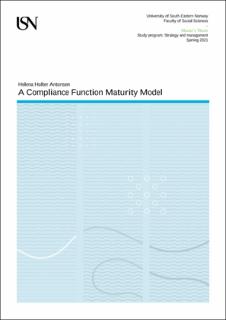A Compliance Function Maturity Model
Abstract
In the Norwegian financial market, the MiFID II directive requires firms to implement a series of systems and controls aimed at securing a robust governance framework. This includes policies and procedures to ensure regulatory compliance and the establishment of a permanent, independent, and effective compliance function (ESMA, 2020b, p. 6).
However, the establishment of an effective compliance function is not solely a requirement from the authorities that for firms represents a necessary evil. Previous research proves that there is a connection between compliance and firms’ profitability and performance (Antonsen, 2020). For that reason, it is seen as important to organize the compliance function to be as effective as possible.
Motivated by this, the current research project aims to develop a maturity model for assessing the maturity of the compliance function within Norwegian investment firms. This, based on the assumption that effectiveness increases with maturity.
Using a narrative literature study to examine previous research on the development of maturity models, the development of a compliance function maturity model was completed by looking to frameworks suggested in existing literature. As part of this, a case study method was used to test the model in practice.
Findings from this research show how the effectiveness of the compliance function can be evaluated using a maturity model. By looking to previous research, ideas from compliance practitioners, and guidelines from the authorities, a path of evolution where the compliance function matures from being reactive and inconsistent to it becoming a proactive and integrated part of a firm’s business endeavors is indicated.
Used in the assessment of the compliance function within a relevant case firm, the suggested model – the CFMM – proved to be compatible with practice. As such, the CFMM represents an improvement framework that can help its intended audience with identifying where a firm’s compliance function stands as of today and further provide guidelines for its improvement. This further implies that the development process, which was inspired by previous research, helped develop a model that was both usable and useful. As such, the findings of this study also recognize the measures suggested by other scholars for developing theoretically and empirically validated maturity models.
